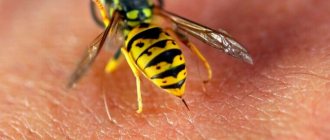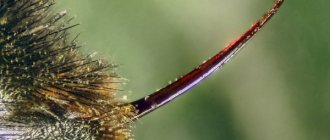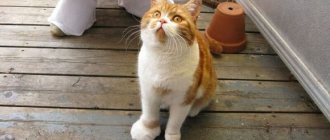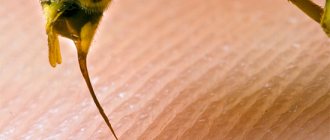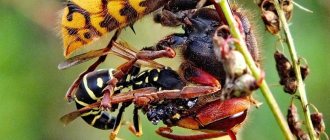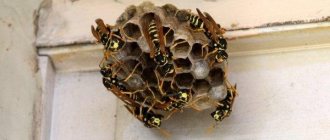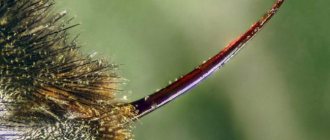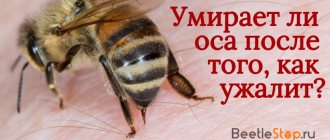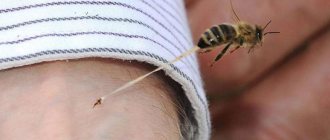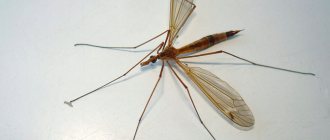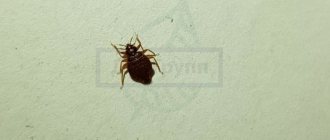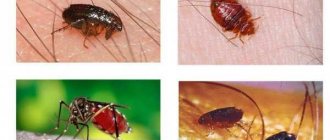The bite of any insect is extremely unpleasant for a person; in addition to the painful shock, it also leaves traces. Well, bees and wasps are leaders in stinging and the effect of surprise.
Wasps do not attack without a reason, and this article will discuss the correct spelling of whether it bites or stings, features, differences with the bee family, and the consequences for insects.
The structure of a wasp sting
Female wasps use their sting for defense and attack. Its role is to paralyze the victim. If it is an insect, it is taken to the wasp hive for food.
The sting consists of:
- poison gland;
- pointed proboscis;
- internal duct.
It is through the internal duct that the poison from the gland enters the victim. The shape resembles a regular needle. Although it is thin, it is quite strong, as it consists of chitin. The formation of the weapon begins in the egg, so males, in principle, do not have the opportunity to possess it. The length of the sting is impressive, since the wasp extends it when biting. The proboscis and duct can be examined using a microscope.
The strength of the venom of different wasps
The external structure of the defensive weapon is identical in all species, but the strength of the poison and the behavior of insects differ significantly.
- The largest wasp is the hornet; its sting is very painful. The poison is toxic. The Asian hornet can kill an allergy sufferer in just a few minutes. Every year in Japan and China, about 50 cases of death after a hornet bite are recorded. The attack has been compared to piercing the skin with a hot nail. Typical representatives of our area are less poisonous, but five bites from different individuals can kill a person without timely medical assistance.
- Scolia giants impress with their impressive size and are among the largest species of wasps in the world. They have a small sting and are non-toxic to humans. After the bite, there is a feeling of numbness that goes away within a few minutes. And only with an increased tendency to allergies does a local, systemic allergic reaction occur. Scolia are distinguished by a calm disposition; they prefer to move away from dangerous places and enemies rather than attack. These types of insects do not communicate by signals and do not build large nests, so an attack by an entire swarm is excluded.
- Philants are the safest wasps, they are burrowers and live underground. They are not capable of piercing human skin. If necessary, you can crush them with your bare hands. The second name for insects is bee wolves. Large ground wasps feed on bees and destroy hives. Until the larva matures, it eats 5 adult bees. Has the ability to attack the victim on the fly. The sting sticks in and paralyzes the bee. Then it squeezes out the nectar, eats it, and takes the prey to the nest. Forms a hive underground and remembers its location well.
- Pompylidae is a wasp with a long sting and strong venom. Delivers the most painful bites. Road wasps bite unbearably painfully and attack at the first sign of aggression towards them. They live all over the world, more than 200 species live in Russia. The body size of an adult reaches 3 cm. They lead a solitary lifestyle, do not form a swarm, and numerous nests. The eggs are laid on spiders, and the larvae subsequently eat the victim from the inside. Pompylids have the most powerful, strong sting. They use it to attack victims and enemies.
If an insect manages to bite a person, it is necessary to wash the wound under running water, which will wash away the particles of poison from the wound and disinfect it. For allergies, a hormonal antihistamine is used.
How dangerous is the poison?
The insect is dangerous because its poison can cause a severe allergic reaction, even leading to death. Many people are unaware of their high sensitivity to this poison until the moment they are bitten. Although wasps sting quite often. The bite is accompanied by sharp pain, the wound swells, and a burning sensation is felt. This is the least you can get away with in such a situation. The consequences may be unforeseen.
The poison contains substances such as:
The whole difficulty lies in the fact that without encountering a wasp, it is impossible to know about the presence of sensitivity to these substances. Therefore, an attack by a stinging insect can lead to unpleasant consequences and even death, although this is a very rare occurrence.
The properties of substances also include:
It is because of the action of the poison that the bite site becomes inflamed and does not heal for a sufficiently long period of time. Itching may also add to the pain. If the pain does not go away after 2 weeks, it is best to consult a doctor.
How much and how long the wound hurts may depend on the type of insect that stung. The bite of some individuals may be completely painless, while others will lead to suffering.
Most bites occur on the arms and legs. But cases of stinging in the head also occur. If the sting gets into the face, it may change beyond recognition. The eyelids swell to such a size that the eyes cannot see anything. Bites on the tongue often occur. This happens when a wasp sits on food, but a person did not notice it and took it into his mouth. The swollen tongue becomes so large that the mouth may not close.
Anatomy of the sting and stinging mechanism
Externally, the sting of a wasp resembles a long thin needle. This is a very durable organ with a channel-duct inside, connected to a poisonous gland. Thanks to this connection, the poison enters the victim’s body through the duct.
Wasp sting under a microscope
In a calm state, the sting is “retracted” to the back of the wasp’s body and hidden there by special plates. In a state of aggression, before a bite, the plates open and the sting “moves out” from the inside along the so-called sled. In fact, the sting is two closed “stilettos”, its walls are smooth, and to the naked eye they appear dark, almost black, but in fact they are translucent. Through the channel-duct between the stylets and the sled, the poison is released into the body of the victim. The stilettos themselves do not have a channel, therefore, if the sting (stilettos) does not penetrate deep enough into the body, the poison may not get there.
Immediately after the bite, having quickly injected the poison, the wasp does not always remove the sting back inside: this allows it to sting several times in a row (on average up to 4-5 times). The wasp is capable of piercing the victim with its sting, provided that the body cover is softer than the sting; otherwise, instead of the sting, the wasp will have to use its powerful jaws.
A wasp only has one sting for its entire life. Even if she loses him, it’s not so scary for her. Loss of a sting is generally not typical for these insects (unlike bees). This is only possible if you slam the wasp at the exact moment of the bite.
Difference from a bee sting
The bee family attacks only if there is disturbance or the nest is in danger. If it doesn’t like something, the bee strikes and leaves a sting in the person’s skin.
As soon as the bee's sting penetrates the tissue, it breaks away from the insect and releases the poisonous element. Next, swelling, a painful sensation and a periodic desire to scratch are formed.
After a sting, it is necessary to inspect the bite site and perform first aid, since after a bite a healthy person will experience a painful shock and the skin around the bite will be inflamed by the poison.
To prevent the consequences of a sting, call an ambulance to remove the bee sting. Do not make sudden movements, otherwise it may break and spread the poison further, which will negatively affect the human body.
A wasp sting is dangerous because these insects are aggressive by nature. They do not need additional factors for a wasp to bite. The process occurs at lightning speed and painfully, and then it may return to repeat the attack. What the bee cannot do, the bee will allow itself.
In addition, wasps and bees have different types of poisons, in the first case serotonin, and in the second acetylcholine, hence the different reactions of the body of a bitten person. But in any case, immediately after the bite, first aid is important, no matter what complicates the situation.
An allergic reaction to insect inhalations may occur. Swelling, itching, and pain are sure to occur. When wasps and bees bite in large numbers, there will be general weakness, headaches, nausea, even vomiting.
Well, we will consider the most important difference between these two types in the next section.
How a wasp bites
Many types of wasps are distinguished by aggressive behavior; they rush to attack when there are sudden movements or when a person approaches. Unlike bees, wasps can sting several times - up to 5 per minute. Attacks until it can fly away. By whether the sting remains in the wound, you can find out who bit, a wasp or a bee.
The female wasp sits on the victim’s body, contracts the muscles, extends the sting, and pierces the skin. The amount of poison entering the blood depends on how deep it goes. Having pulled the weapon back, the insect is in no hurry to hide it and is able to stab it several more times. How many times a wasp bites depends on the age of the insect, the species, and the strength of the poison. Representatives of the social family inflict up to 5 bites at a time. A photo of a wasp sting in the skin is shown below.
Interesting!
Wasps attack people to protect their lives, nests, and larvae. If an inattentive, careless person finds himself near a wasp hive, he risks being bitten by a whole swarm. Insects living in a large family communicate with signals and, if there is danger, notify others. In a matter of minutes, a whole swarm appears out of nowhere, rushes to attack, and can bite for several minutes.
Wasp sting
How long do wasps live?
In early spring, the young queen begins building a nest and laying eggs. All summer, immature females appear - working individuals. They perform different functions, provide hive construction, protection, obtain food, and feed larvae. Life expectancy is no more than a month. The wasp society is rapidly expanding. By the end of summer the population numbers several hundred individuals.
In August, the wasps begin to attach additional honeycombs, which are slightly larger in size. There the queen lays eggs, from which females and males emerge. After birth, they remain in the hive for some time, then fly outside to mate.
Working individuals eat larvae, underdeveloped eggs, and leave the nest, on the construction of which they worked throughout the warm season. At the beginning of autumn they become slow and not so aggressive. With the onset of the first frosts they begin to die. Young queens hide in tree hollows, crevices, and wooden buildings. According to some sources, old queens die along with their family, according to others, they winter safely and live for about 2 years.
The bite does not affect life expectancy unless the person intentionally kills the attacker. In most cases, death occurs naturally or during a confrontation with a natural enemy.
Why do wasps bite?
These insects cannot be called aggressive. Not a single one, even the most dangerous representative of this family, will attack you just like that. A wasp usually stings when it senses danger. For example, if you find their nest and disturb it or try to destroy it, the insects will respond with aggression.
In addition, they are attracted to the smells of certain foods:
- Meat
- Fish
- Grilling kebabs.
Once you start cooking outside, you will instantly be surrounded by these insects. And in such a situation you need to behave extremely carefully, without making sudden movements, otherwise you will not avoid a bite.
Basically, when hunting, insects try to save poison, and kill their victims with powerful jaws.
There is another reason why you may be stung - the use of cosmetics and perfumes. It is a scientifically proven fact that insects associate the odors of some of these products with a danger signal. What makes them attack people, as it seems to us, for no reason.
First aid for a bee or wasp sting
A bee or wasp injects poison into the human body using its sting. Therefore, the skin swells, turns red and hurts. If you have been stung by a wasp or a bee, you must urgently take action and provide first aid:
- Get the sting. This can be done using tweezers or a needle. The tweezers or needle should be wiped with a disinfectant solution, and after removing the tip, the skin area should also be disinfected.
- Apply a cooling compress or ice.
- Take an antihistamine (Eden, Claritin, Fenistil, L-cet, Diazolin, Erius, Zodak, etc.)
After the bite, pain and swelling can be felt for a long time. Wasp stings tend to be more painful than bee stings.
Children are often stung by bees or wasps:
Therefore, your first aid kit should always contain the following items to help your child:
- Antihistamine syrup. It is recommended to take it, even in the absence of signs of allergy, the syrup will relieve pain.
- Cooling ointments for insect bites (Moskitol, Psilo-Balm, Fenistil gel).
- You can apply skin-restoring creams to the bite area (Bepanten, Panthenol, Dexpanthenol, baby cream).
If such a nuisance happens to a child, do not panic, this will cause even greater fear in an already excited baby. Try not to panic and provide timely assistance to the child. Children are unlikely to have a strong reaction to the first bee sting. But this case may provoke insect allergies in the future.
There are terrible cases when a person is allergic to bee and wasp stings. The person's condition may be poor:
- The temperature may rise.
- Swelling extends more than 10 cm from the point of the bite.
- There is dizziness, shortness of breath, heavy breathing.
- Heart rate increases.
How to remove a sting
Removing stings from skin is more about bee stings than wasp stings. However, if it so happens that the wasp sting remains inside, it must be removed in the same way as a bee sting:
- It’s best to take tweezers and disinfect them;
- you need to pull out the sting very carefully so that it comes out entirely (when stung by a bee, pull on the remaining part of the abdomen);
- to alleviate the condition after removing the sting, use traditional or folk methods (applying cold is good as first aid);
- treat the wound so that it does not get infected (you can use iodine);
- In case of complications, consult a doctor immediately.
How to destroy a wasp's nest
Wasps and hornets make their nests in attics, barns and outbuildings, and livestock buildings (where they can also sting animals, which can lead to harmful consequences). The nest, as a rule, is at the very beginning, when eggs are just laid there or larvae hatch, and is still very small. It is recommended to destroy nests at this stage, after making sure that there is no adult in the nest. An overgrown large nest may be full of wasps. It is necessary to destroy it in any case - wasps can cause irreparable harm to people or pets. You can contact a specialized pest control service to have the problem solved by professionals.
Hornet
You can destroy the nest yourself. But you have to be careful. The wasp's nest is always reliably guarded; any intrusion into the territory is regarded by insects as a threat. An immediate attack will follow, even in cases where there is absolutely no reason for this.
When starting to destroy a nest, you need appropriate protective equipment:
- thick clothing, preferably multi-layered, preferably in canvas;
- A beekeeper's mask is required;
- durable gloves, preferably rubberized.
Attention! You can place a container with syrup a few meters from the nest. This will distract the wasps.
To destroy nests, poisonous sprays are recommended. You need to take a large bag without holes, cut off the handles and put it on the honeycomb. Then secure with tape, cut the far edge, release spray into the cut, tie the cut, remove the bag and the dead wasps after a day.
Attention! It is recommended to work in a respirator or gas mask.
Also, the nest can be sprayed with pesticides; if it is not indoors, but on the site and not on a tree, then you can treat it with a flammable mixture and burn it.
A more difficult problem is ground wasps. They are larger in size and make their homes underground, which does not always make it possible to find them in time. Their homes can be filled with cement, water (boiling water, about 2-3 buckets), carbide (put in a hole, fill with water, plug the exit with rags soaked in gasoline).
Swarm of wasps
Attention! To protect children from wasp bites, it is necessary to instruct them about precautions, that they should not climb into nests or try to catch insects.
Speaking about the destruction of wasps, it is necessary to understand that they cause harm to humans, being aggressive and vindictive insects that can sting repeatedly, being extremely dangerous, especially for children and allergy sufferers. In addition, wasps are carriers of diseases, as they feed on waste from garbage dumps. It is not recommended to destroy bees due to the fact that they are beneficial, they are less aggressive and they live in hives in apiaries, and do not build nests in human homes.
The question: do the stings remain after wasp bites - definitely not. By following the instructions above, you can avoid being stung by wasps and bees, and also get rid of nests of insects dangerous to humans.
5 1 vote
Article rating
Difference between the sting of a worker bee and a queen bee
Of those who have a sting in a bee colony, in addition to worker bees, it is necessary to mention the queen. Since the queen, unlike sterile workers, uses the ovipositor for its intended purpose - to lay eggs, it is better developed and longer than that of ordinary bees. In addition, the queen's sting has only 3 serrations, so she can easily pull it out even from soft tissues.
Bee sting
How to help at home?
If there are no medicines at hand, folk remedies that can be found in every home can help. By the way, natural remedies will also come in handy if a wasp has bitten a pregnant woman, for whom the list of approved medications is very limited. More often than others, the following are used to treat the bite site:
- aloe juice or pulp;
- a slurry of soda mixed with water;
- sour fruit (lemon, sour blocks);
- diluted apple cider vinegar;
- tomato pulp (both ripe and green);
- grated fresh potatoes.
Grated potatoes
Some housewives advise adding chopped onion or garlic, but the juice of these plants is very caustic, so the method is not suitable for everyone. In particular, such lotions are not recommended for treating wasp stings during pregnancy
What to do if bitten by a wasp?
Let us consider in detail what to do if it was not possible to avoid a wasp attack. The child must inform adults about this. Below are the measures that should be taken first, as well as how to protect yourself and your loved ones.
How to remove the sting?
Bees bite much more often than wasps. Therefore, a stung person cannot always accurately determine who attacked him. A wasp sting very rarely remains in the human body. This is only possible if it breaks off. The site must be inspected immediately. Since the wound swells quickly, examination will not yield results after a few minutes.
You should immediately treat the wound and apply cold to reduce swelling. If it is impossible to examine and remove the sting on your own, then you should seek help. To remove it you will need a magnifying object, good lighting and tweezers. Having grabbed the head, you should immediately pull the sting out of the wound.
Don't try to squeeze out the poison. There is a high probability that it will go deeper into the skin and enter the blood. This can lead to a serious inflammatory process.
First aid
Proper first aid can significantly reduce the risk of an anaphylactic reaction. What to do in this situation:
- Place the stung person in a cool place. High temperatures can worsen the victim's condition. Do not let your head tilt to the side or back.
- Wash the wound and treat with an antiseptic.
- Apply ice or any cold compress to reduce swelling and pain.
- Apply a remedy to the wound that eliminates local reactions. For example, cream “Rescuer”.
- Give an antihistamine. For children, use age-appropriate medications.
Advice! When going outdoors, it would be good to pack a first aid kit with you to provide first aid in such situations.
- Drink as much water as possible.
- If an anaphylactic reaction occurs, call an ambulance.
Allergic reaction
The action of immunoglobulins in a healthy body can neutralize the effect of poisons. Its production begins immediately after the foreign substance enters the body.
If the person bitten is allergic to wasp venom, the reaction to the bite may be unpredictable. You can distinguish an allergic reaction from a normal one by the location of the bite. The first thing that will confirm the guesses is large swelling, more than 1 cm in diameter. The further occurrence of reactions depends on the human body.
Interesting! Allergy sufferers are issued special passports indicating personal data, allergen tests and first aid measures.
Allergy symptoms also:
- rash;
- strong pain;
- burning, itching;
- hives.
In addition to local reactions, the following may appear:
- headache, dizziness;
- nausea;
- decrease in blood pressure;
- difficulties with the breathing apparatus;
- elevated temperature;
- pale skin;
- muscle spasm.
The manifestation of the listed symptoms can begin within 20 minutes after the sting.
Anaphylactic shock that develops within the first 5 minutes is a strong and dangerous reaction of the body. It begins with difficulty breathing and swelling of the larynx. If such a reaction occurs, immediate medical attention must be provided. Prednisolone and adrenaline are administered, and a tourniquet is applied above the wound. Further treatment is carried out in a hospital setting.
